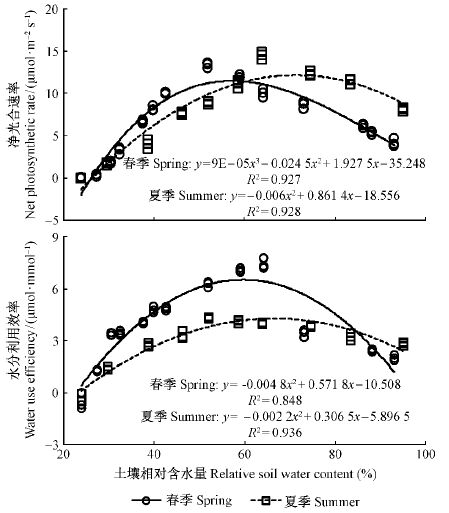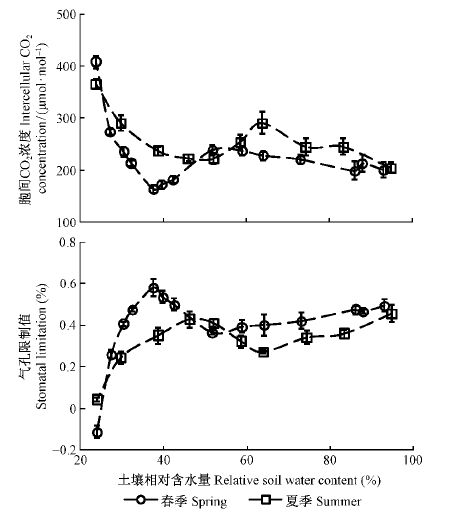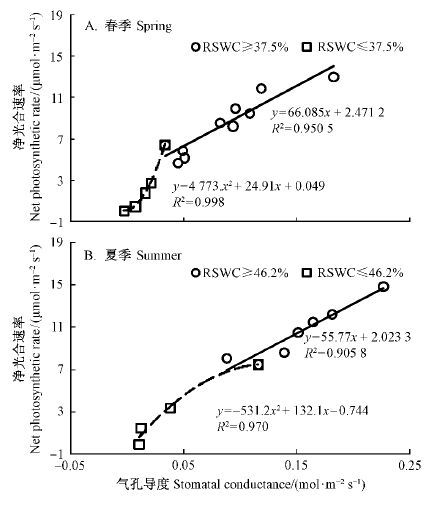文章信息
- 郎莹, 汪明
- Lang Ying, Wang Ming
- 春夏两季连翘光合作用的土壤水分阈值效应及生产力分级
- Threshold Effect of Photosynthesis in Forsythia suspense to Soil Water and its Photosynthetic Productivity Grading in Spring and Summer
- 林业科学, 2016, 52(2): 38-46
- Scientia Silvae Sinicae, 2016, 52(2): 38-46.
- DOI: 10.11707/j.1001-7488.20160205
-
文章历史
- 收稿日期:2014-12-03
- 修回日期:2015-10-27
-
作者相关文章
2. 地表过程与资源生态国家重点实验室 北京师范大学减灾与应急管理研究院 北京 100875
2. State Key Laboratory of Earth Surface Processes and Resource Ecology Academy of Disaster Reduction and Emergency Management, Beijing Normal University Beijing 100875
土壤水分胁迫(尤其是干旱胁迫)是制约植物光合作用和生长发育的最主要因素之一(Chaves et al., 2002)。干旱半干旱地区的植物在其生命周期中,特别是以天然降水为主要水分来源的森林生态系统,经常遭受土壤干旱或大气干旱(Law et al., 2000; Wilson et al., 2001); 气候变化下,即使处于热带雨林的植物,水分也极有可能在未来成为影响其生产力的主要限制因子(Fischer et al., 2001)。近年来,全球气候变化驱动导致的极端水分胁迫已经威胁到森林生态系统的可持续发展(Boyer,1982; Varela et al., 2010),使植物光合作用和生产力严重下降(李晓兵等,2002; Suresh et al., 2010; Ou et al., 2011; Lang et al., 2013)。
植物遭遇水分胁迫后其光合生理生态响应与植物基因型、水分胁迫程度和胁迫发生时植物所处的生长发育时期有关(安玉艳等,2012; 郎莹等,2015),且土壤水分过高或过低均会导致植物光合作用下降和生物量降低(张淑勇等,2007; 陈建等,2008; 郎莹等,2011; Lang et al.,2013; 裴斌等,2013)。因此,如何通过季节性土壤水分和特定植物的定量关系研究,达到既高效利用有限水资源又提高植物生产力的目的,是区域植物水分管理亟需解决的重要问题之一。
20世纪20年代以来,土壤-植物系统水分关系一直是植物水分生理学的重要研究领域(Veihmeyer et al., 1927; Richards et al., 1952; 杨文治等,2000; Zhang et al., 2012; 夏江宝等,2011; 2013)。早期土壤水分对植物有效性的研究可概括为等效学说和非等效学说(Veihmeyer et al., 1927; Richards et al., 1952),2种学说因不同学者选取的评价指标[如果树生产量(Veihmeyer et al., 1934)、主茎伸长速率(Blair et al., 1950)、蒸腾速率及叶片水分亏缺(沈善敏等,1964)]不同而有所不同,并且所选指标不能揭示植物对土壤水分利用效率及其与植物生产力之间的关系。之后,随着土壤-植物—大气连续体(SPAC)概念和理论的提出以及水分运动测定技术的进步,很多学者开始探索根系吸水模型来衡量土壤水分对植物的有效性(刘昌明等,1999; 杨文治等,2000),但模型在应用时常因含有难以确定或模糊的参数而受到限制(李秧秧,2001)。近几年来,有学者基于植物水分生理生态学原理,将植物光饱和点时的光合作用净光合速率(Pn)和水分利用效率(WUE)分别作为衡量土壤水分对植物“产”和“效”的指标,对土壤水分进行分级评价,并确定植物高产、高效水分范围(Zhang et al., 2012; 夏江宝等,2011; 2013),较好地表达了传统农业研究中产(生物量多少)和效(根系吸水难易)的概念。但是已有研究多数只关注了植物某一生长发育时期(如叶片成熟期)的土壤水分有效性(Zhang et al., 2012; 夏江宝等,2011; 2013; 张淑勇等,2014),缺乏不同季节间土壤水分有效性的节律研究。
华北地区春旱夏涝灾害频繁(张庆云等,2003),受气候变化驱动影响,该地区呈暖干化趋势(王长燕等,2006),春、夏季平均干旱程度增大(魏凤英等,2003; 魏凤英,2004),且极端降水事件增多。本研究以该地区常见的抗旱绿化观赏树种连翘(Forsythia suspensa)为材料开展温室试验,以光合作用净光合速率(net photosynthetic rate,Pn)和水分利用效率(water use efficiency,WUE)分别作为评价土壤水分对连翘的“产”、“效”指标,通过分析春、夏季连翘光合作用对连续土壤水分变化的响应过程,阐明连翘光合作用的土壤水分阈值及其生产力分级范围,并进行季节间比较,旨在为春、夏季土壤水分胁迫下植物的风险诊断和田间植物的土壤水分管理提供科学依据。
1 材料与方法 1.1 试验设计2012年3月下旬,于受控温室内布设盆栽苗木,设计春季(2012年4月30日—5月16日)、夏季(2012年6月30日—7月12日)2个季节的对比试验,每个季节测定3株试验苗木的土壤水分变化和叶片光合作用变化。试验期间,利用补光光源、水帘、风机和循环风机控制温室内光强、温度、空气相对湿度分别为外界光强的90%,18~30 ℃和41%~65%,CO2浓度为380~400 μmol·mol-1。试验土壤为棕壤,取自山东省邹平县鹤伴山。
1.2 试验材料2012年3月25日,从苗圃中挑选30株健康、无病虫害、生长势(株高、地径)一致的连翘2年生苗木,栽植于受控温室的30个花盆中进行水肥管理与水分控制,花盆深60 cm、直径40 cm。苗木栽植前,修剪运输过程中受损的根系和枝条,并保证修剪后所有苗木的根长为12 cm左右,以防止试验中根系继续生长受栽植盆大小的限制(郎莹等,2015)。苗木栽植后立即浇充足水,之后进行正常水分管理(每周浇2次水)。2012年4月25日,从30株植株中挑选12株株高、地径相对一致的苗木作为春、夏季试验植株。2012年4月30日和6月30日从12株植株中分别挑选3株作为春、夏季试验测定植株,用于多级土壤含水待测量和叶片光合作用光响应过程测量。
1.3 试验方法 1.3.1 土壤水分测定利用环刀法测得试验土壤的密度(ρ)为(1.25±0.3)g·cm-3,田间持水量(field capacity,FC)为30.95%±0.9%。通过人工充足给水后植株自然耗水的方法获取春、夏季多级连续土壤水分梯度,即试验开始前2天(春季: 2012年5月1日; 夏季: 2012年7月1日)的18:00对试验植株充足浇水,使其达到田间持水量(FC); 浇水后第3天(春季: 2012年5月3日; 夏季: 2012年7月3日)开始,利用6050X3K1B Mini Trase Kit土壤水分测量系统(California,USA)每天上午8:00测定0~60 cm土层的土壤体积含水量(volumetric soil water content,VSWC),直到Pn≈0为止,并计算得到质量含水量(gravitational soil water content,GSWC)和相对含水量(relative soil water content,RSWC)(郎莹等,2015)。每处理3株,每株测定3个样点,每个样点记录3个读数。通过测量得到春季14组水分梯度,其平均RSWC分别为93.0%,88.1%,86.2%,73.0%,64.1%,59.0%,51.8%,42.6%,39.8%,37.5%,32.4%,30.4%,27.3%和23.9%,夏季10组水分梯度,其平均RSWC分别为94.5%,83.3%,74.5%,63.8%,58.6%,52.0%,46.2%,38.7%,29.7%和23.9%。
1.3.2 光合指标测定连翘叶片光合作用测量和土壤水分测量同时进行。试验开始前2天(春季: 2012年5月1日; 夏季: 2012年7月1日),从试验植株中上部枝条的第3~4片叶片中挑选生长健壮、无病虫害的3片叶片进行标记。2012年5月3日(春季试验)和7月3日(夏季试验)开始,于每天上午8:30—11:00,利用Li-6400光合作用测定系统(Li-Cor,USA)随机选取2片标记叶片进行光合作用光响应过程测定。
测定时,每个叶片重复3次,每次光响应过程的光合有效辐射强度(photosynthetically active radiation,PAR)依次设定为1 800,1 600,1 400,1 200,1 000,800,600,400,200,150,50,20,0 μmol·m-2s-1,每个光合有效辐射强度下控制120 s。仪器自动记录净光合速率(Pn)、气孔导度(Gs)、蒸腾速率(transpiration rate,Tr)、胞间CO2浓度(Ci)、大气CO2浓度(Ca)等气体交换参数,由此可计算连翘叶片水分利用效率(WUE)和气孔限制值(Ls)(Smith et al., 2007; 郎莹等,2015)。
1.4 数据分析利用Excel 2007、SPSS 20.0和Matlab 2010软件处理春、夏季不同水分处理的土壤含水量和叶片气体交换参数(Pn,Tr,WUE,Ci,Ls)并作图。通过绘制净光合速率光响应曲线,得到各土壤水分梯度下的光饱和点(LSP)及相应叶片气体交换参数(郎莹等,2015)。利用单因素方差分析(ANOVA)进行不同处理之间的差异显著性分析(显著性水平α=0.05)。
2 结果与分析 2.1 Pn,WUE土壤水分阈值从图 1可知,春、夏季Pn对RSWC、WUE对RSWC均表现出明显的阈值响应规律,即随着RSWC逐渐降低,Pn,WUE均先增大后减小。同时,春、夏季Pn和WUE对RSWC的阈值响应过程均可以用多项式较好地拟合(R2>0.8)。

|
图1 春夏连翘季净光合速率、水分利用效率响应土壤水分的多项式拟合 Fig.1 The polynomial fittings of net photosynthetic rate ( Pn )and water use efficiency (WUE) of F. suspense responding to soil water in spring and summer |
以春季Pn对RSWC的响应过程为例,Pn对RSWC的响应过程符合三项式模型:
| $${P_n} = 9{\rm E} - 05 \times {\text{RSW}}{{\text{C}}^3} - 0.0245 \times {\text{RSW}}{{\text{C}}^{\text{2}}}{\text{ + 1}}{\text{.9275}} \times {\text{RSWC}} - 35.248$$ | (1) |
根据拟合的多项式(1),在Matlab软件中计算得到春季Pn的零值、最大值对应的土壤相对含水量分别为26.1%和57.7%,即春季Pn水分补偿点(RSWCPn=0)为26.1%,Pn水分饱和点(RSWCPn=max)为57.7%(夏江宝,2013)(表 1)。
|
|
根据式(1),得到试验水分范围(23.9%≤RSWC≤93.0%)内Pn均值的计算公式(2):
$$\eqalign{
& \overline {{{\text{P}}_n}} = \frac{{\int_{23.9\% }^{93.0\% } {{{\text{P}}_n}{\text{dRSWC}}} }}{{93.0\% - 23.9\% }} = \cr
& \frac{{\int_{23.9\% }^{93.0\% } {(9E - 05 \times } {\text{RSW}}{{\text{C}}^3} - 0.0245 \times {\text{RSW}}{{\text{C}}^2} + 1.9275 \times {\text{RSWC}} - 35.248){\text{dRSWC}}}}{{93.0\% - 23.9\% }} \cr} $$
(2)
根据${\bar P_n} = 8.21$,利用式(1)计算春季Pn平均值 对应的RSWC为39.5%和80.0%,即春季Pn均值点(RSWCPn=ave)为39.5%和80.0%(表 1)。
与春季Pn对RSWC的多项式拟合响应过程相似,春季WUE、夏季Pn和WUE对RSWC的响应过程均符合多项式模型(图 1)。利用同样的水分阈值计算方法,分别计算得到春季WUE和夏季Pn,WUE的土壤水分阈值(表 1)。从表中可以看出: 春、夏季Pn水分补偿点差异不显著(P>0.1),而夏季Pn水分饱和点、WUE水分高效点(RSWCWUE=max)、气孔限制转折点(RSWCSL→nSL)均高于春季,夏季Pn均值点和WUE均值点(RSWCWUE=ave)的上、下限也高于春季(P < 0. 05 ),这可能与夏季连翘因发育成熟对水量要求较高有关。
由图 2可知,春、夏季Ci-RSWC曲线相似,即随着RSWC逐渐降低,Ci先增大后减小,当春季RSWC=37.5%、夏季RSWC=46.2%时,Ci又急剧增大; 而2个季节Ls随RSWC的变化趋势则呈相反的规律。因此,结合Pn-RSWC曲线(图 1)可知,当春季RSWC=37.5%、夏季RSWC=46.2%时,连翘Pn下降的机制由气孔限制主导转变为非气孔限制主导,即此水分点分别为春、夏季光合作用气孔限制向非气孔限制转折的水分点(RSWCSL→nSL)(表 1)。

|
图2 春、夏季胞间CO2 浓度、气孔限制值对土壤相对含水量的响应 Fig.2 The response of intercellular CO2 concentration ( Ci )and stomatal limitation ( Ls ) to relative soil water content (RSWC) |
由图 3可知,不同水分范围内Pn-Gs的正比关系不同。当春季RSWC≥37.5%、夏季RSWC≥46.2%时,随着Gs增大,Pn线性增大,Pn和Gs为线性正比关系; 当春季RSWC≤37.5%、夏季RSWC≤46.2%时,Pn和Gs为非线性正比关系。因此,当春季RSWC=37.5%、夏季RSWC=46.2%时,连翘不仅发生了光合作用限制机制的转变,其Pn和Gs之间的正比关系也发生转变。

|
图3 春、夏季净光合速率和气孔导度的关系 Fig.3 Relationship between net photosynthetic rate ( Pn )and stomatal conductance ( Gs ) in spring and summer |
以Pn和WUE分别作为衡量土壤水分对植物“产”(生物量多少)、“效”(根系吸水难易)的指标,结合春、夏季连翘Pn,WUE,Ci,Ls随RSWC的变化规律(图 1,2),以各土壤水分阈值为临界点(表 1),借助坐标轴图示(图 4),对2个季节的土壤水分有效性进行分级(表 2):

|
图4 春、夏季土壤水分分级坐标轴图示 Fig.4 The coordinate graphic figures of soil water grading in spring and summer non-productivity and non-efficiency water; LPLEW: low productivity and low efficiency water; MPMEW: middle productivity and middle efficiency water; HPMEW: high productivity and middle efficiency water; HPHEW: high productivity and high efficiency water |
|
|
当RSWC低于Pn水分补偿点,即春季RSWC≤26.1%、夏季RSWC≤26.4%时,Pn≤0,WUE≤0,连翘没有光合有机物积累,因此,将春季RSWC≤26.1%、夏季RSWC≤26.4%水分范围作为“无产无效水”。
当春季RSWC=37.5%、夏季RSWC=46.2%时,连翘光合作用下降的主要原因由气孔限制转变为非气孔限制,光合机构、酶活性开始受到破坏或失活(许大全,1997),同时此水分点也是维持植物正常生长允许的最低水分亏缺(山仑等,1991),即当春季26.1%≤RSWC≤37.5%、夏季26.4%≤RSWC≤46.2%时,连翘光合机构开始破坏、酶活性降低的非气孔限制导致连翘光合生产力较低,且不能维持正常生长,因此将春季26.1%≤RSWC≤37.5%、夏季26.4%≤RSWC≤46.2%作为“低产低效水”。
当春季39.5%≤RSWC≤80.0%、夏季47.8%≤RSWC≤95.7%时,连翘Pn高于平均水平,其中春季RSWC=57.7%、夏季RSWC=71.8%时,连翘Pn有最大值; 春季39.5%≤RSWC≤80.0%、夏季49.2%≤RSWC≤83.7%时,连翘WUE高于平均水平,其中春季RSWC=59.6%、夏季RSWC=69.5%时,连翘WUE有最大值。因此,当春季39.5%≤RSWC≤80.0%、夏季49.2%≤RSWC≤83.7%时,连翘具有较高(高于平均值)的Pn和WUE,且能达到最高“产”、最高“效”水平,笔者将此水分范围(春季39.5%≤RSWC≤80.0%;夏季49.2%≤RSWC≤83.7%)作为“高产高效水”。同时,在低于Pn均值点而高于气孔限制转折点的土壤水分范围内连翘Pn低于平均水平,称为“中产水”; 在低于WUE均值点而高于气孔机制转折点的土壤水分范围内连翘WUE低于平均水平,称为“中效水”,由此得到春、夏季“中产中效水”和“高产中效水”。
通过土壤水分有效性分级可知,夏季低产低效水的上限,中产中效水和高产高效水的上限、下限均高于春季(P < 0. 05),而春、夏季无产无效水分范围相差不大((P > 0. 1),这表明土壤水分植物有效的水分范围(低产低效水、中产中效水、高产高效水)内,夏季对土壤水分含量的要求较高。
3 讨论与结论 3.1 讨论因研究方法和评价标准不同,利用植物根系吸水的难易程度评价土壤水分对植物的有效性,得到的结论也不一致(刘昌明等; 1999; 杨文治等,2000)。近年来,有学者基于植物水分生理生态学原理对土壤水分进行分级评价,最常用的方法为临界值分类法,即通过界定土壤水分“产”、“效”定义选定分级指标,确定土壤水分临界点,进而对土壤水分进行分级评价,评价时都选用了光合作用Pn和WUE作为土壤水分的“产”、“效”指标(夏江宝等,2011; 2013; Zhang et al., 2012)。目前,临界值分类法按土壤水分临界点确定时所采用的数学方法不同主要分为3类: 一是聚类分析法(夏江宝等,2011),即将试验获取的多个水分梯度下的Pn和WUE进行聚类得到不同的土壤水分等级,该方法获取的水分临界点主要依据试验获取的土壤水分值,确定的水分临界点缺乏一定的生理学意义; 二是极值法(张光灿等,2003; Zhang et al., 2012),即以Pn、WUE的最小值、最大值和气孔机制转折点作为土壤水分阈值,该方法确定了土壤水分“产”、“效”最低限值和最高限值; 三是多项式拟合法(夏江宝等,2013),即通过拟合方程计算各土壤水分临界点,如水分补偿点、均值点和饱和点的拟合值,该方法对土壤水分分级比较完整。本研究在第2,3种方法的基础上,利用多项式拟合法计算各土壤水分阈值,考虑气孔机制转变水分点对光合作用的影响,借助坐标轴图示,以水分补偿点、气孔机制转折点、均值点分别作为“低产/效”、“中产/效”和“高产/效”水分范围的下限值,将春、夏季连翘土壤水分分为“无产无效水”、“低产低效水”、“中产中效水”、“高产中效水”和“高产高效水”5个等级,此是对土壤水分分级极值法和多项式拟合法的补充(张光灿等,2003; 夏江宝等,2011; 2013; Zhang et al., 2012)。
土壤水分胁迫下,植物叶片的气孔部分关闭、CO2扩散受阻引起的气孔限制和碳代谢过程受损而发生的非气孔限制,使植物的净光合速率降低(Quick et al., 1992; Evans et al., 2000)。轻度水分胁迫下,植物叶片气孔部分关闭,导致气孔导度降低,CO2扩散受阻,进而使胞间CO2浓度降低(Chaves et al., 2002; 2003; Flexas et al., 2004); 当胁迫继续加重时,胞间CO2浓度反而快速增加,植物发生光合机构破坏或酶活性降低的光合作用非气孔限制(Flexas et al., 2004)。本研究通过观测饱和含水量至Pn≈0含水量范围内连翘Pn,WUE,Ci,Ls与RSWC的响应关系发现,当春季RSWC降低至37.5%、夏季RSWC降低至46.2%时,Pn,WUE显著降低,且净光合速率降低的主要原因由气孔限制转为碳代谢过程受损的非气孔限制,Pn和Gs之间由线性正比关系转为非线性正比关系。 山仑等(1991)、张光灿等(2003)将光合作用气孔机制转折点作为树木维持正常生长的最低水分亏缺,指出当土壤水分达到气孔机制转折点时,若水分胁迫继续加重,则光合生产力严重下降,植物的叶子将可能枯黄甚至凋落。因此,本研究将春季RSWC=37.5%、夏季RSWC=46.2%(光合作用气孔机制转折水分点)作为连翘正常生长的下限阈值并进行“产”、“效”分级。而且,在连翘大田水分管理中,应保证春季RSWC≥37.5%、夏季RSWC≥46.2%的水分范围。
3.2 讨论土壤水分阈值(水分补偿点除外)存在显著的季节性差异,这可能与植物对水量要求因生长发育时期不同而不同。全球气候变化下,华北地区春、夏季干旱严重,导致植物生产力和供水总量下降。当春季39.5%≤RSWC≤80.0%、夏季49.2%≤RSWC≤83.7%时,连翘Pn,WUE均高于平均“产”、“效”水平,且能达到最高“产”、最高“效”水平。因此,气候变化下,为达到较高的“产”、“效”水平,需维持连翘土壤水分范围为春季39.5%≤RSWC≤80.0%、夏季49.2%≤RSWC≤83.7%,本研究土壤水分分级中将此水分范围定义为了春、夏季连翘的高产高效范围。
| [1] |
安玉艳, 梁宗锁. 2012. 植物应对干旱胁迫的阶段性策略. 应用生态学报, 23(10):2907-2915. (An Y Y, Liang Z S. 2012. Staged strategy of plants in response to drought stress. Chinese Journal of Applied Ecology, 23(10):2907-2915.[in Chinese])(  1) 1)
|
| [2] |
陈建, 张光灿, 张淑勇, 等. 2008. 辽东楤木光合和蒸腾作用对光照和土壤水分的响应过程. 应用生态学报, 19(6):1185-1190. (Chen J, Zhang G C, Zhang S Y, et al. 2008. Response processes of Aralia elata photosynthesis and transpiration to light and soil moisture. Chinese Journal of Applied Ecology, 19(6):1185-1190.[in Chinese])(  1) 1)
|
| [3] |
郎莹, 汪明. 2015. 春、夏季土壤水分对连翘光合作用的影响. 生态学报, 35(9):3043-3051. (Lang Y, Wang M. 2015. Effects of soil water on photosynthesis of Forsythia suspensa (Thunb.) Vahl. in spring and summer. Acta Ecologica Sinica, 35(9):3043-3051.[in Chinese])(  5) 5)
|
| [4] |
郎莹, 张光灿, 张征坤, 等. 2011. 不同土壤水分下山杏光合作用光响应过程及其模拟.生态学报, 31(16):4499-4508. (Lang Y, Zhang G C, Zhang Z K, et al. 2011. Light response of photosynthesisand its simulation in leaves of Prunus sibirica L. under different soil water conditions. Acta Ecologica Sinica, 31(16):4499-4508.[in Chinese])(  1) 1)
|
| [5] |
李晓兵, 陈云浩, 张云霞, 等. 2002. 气候变化对中国北方荒漠草原植被的影响. 地球科学进展, 17(2):254-261. (Li X B, Chen Y H, Zhang Y X, et al. 2002. Impact of climate change on desert steppe in northern China. Advance in Earth Sciences, 17(2):254-261.[in Chinese])(  1) 1)
|
| [6] |
李秧秧. 2001. 土壤-植物系统水分关系的试验研究. 西安:西北农林科技大学博士学位论文. Li Y Y. 2001. The experimental studies on water relations of soil-plant system. Xi'an:PhD thesis of Northwest A&F University.[in Chinese])( 1) 1)
|
| [7] |
刘昌明, 王会肖. 1999. 土壤-作物-大气界面水分过程与节水调控. 北京:科学出版社. Liu C M, Wang H X. 1999. Water process and water saving regulation of soil-crop-atmosphere interface. Beijing:Science Press.[in Chinese])( 1) 1)
|
| [8] |
裴斌, 张光灿, 张淑勇, 等. 2013. 土壤干旱胁迫对沙棘叶片光合作用和抗氧化酶活性的影响. 生态学报, 33(5):1386-1396. (Pei B, Zhang G G, Zhang S Y, et al. 2013. Effects of soil drought stress on photosynthetic characteristics and antioxidant enzyme activities in Hippophae rhamnoides Linn. seedings. Acta Ecologica Sinica, 33(5):1386-1396.[in Chinese])(  1) 1)
|
| [9] |
山仑, 徐萌. 1991. 节水农业及其生理生态基础. 应用生态学报, 2(1):70-76. (Shan L, Xu M. 1991. Water-saving agricul and its physio-ecological bases. Chinese Journal of Applied Ecology, 2(1):70-76.[in Chinese])(  2) 2)
|
| [10] |
沈善敏, 卢明远. 1964. 土壤水分对大豆有效性的初步研究. 土壤通报, (2):35-39. (Shen S M, Lu M Y. 1964. The preliminary research on effectiveness of soil water on soybean. Chinese Journal of Soil Science, (2):35-39.[in Chinese])(  1) 1)
|
| [11] |
王长燕, 赵景波, 李小燕. 2006. 华北地区气候暖干化的农业适应性对策研究. 干旱区地理, 29(5):646-652. (Wang C Y, Zhao J B, Li X Y. 2006. Study on agricultural adaptation to warming and drying climate in North China. Arid Land Geography, 29(5):646-652.[in Chinese])(  1) 1)
|
| [12] |
魏凤英, 张京江. 2003. 华北地区干旱的气候背景及其前兆强信号. 气象学报, 61(3):354-363. (Wei F Y, Zhang J J. 2003. Climatological background and previous stronger signal of anomaly drought over North China. Acta Meteorologica Sinica, 61(3):354-363.[in Chinese])(  1) 1)
|
| [13] |
魏凤英. 2004. 华北地区干旱强度的表征形式及其气候变异. 自然灾害学报, 13(2):32-38. (Wei F Y. 2004. Characterization of drought strength in North China and its climatic variation. Journal of Natural Disasters, 13(2):32-38.[in Chinese])(  1) 1)
|
| [14] |
夏江宝, 张光灿,孙景宽,等.2011.山杏叶片光合生理参数对土壤水分和光照强度的阈值效应.植物生态学报,35(3):322-329. (Xia J B, Zhang G C, Sun J K, et al. 2011. Threshold effects of photosynthetic and physiological parameters in Prunus sibirica to soil moisture and light intensity. Chinese Journal of Plant Ecology, 35(3):322-329.[in Chinese])(  6) 6)
|
| [15] |
夏江宝, 张淑勇, 赵自国, 等. 2013. 贝壳堤岛旱柳光合效率的土壤水分临界效应及其阈值分级. 植物生态学报, 37(9):851-860. (Xia J B, Zhang S Y, Zhao Z G, et al. 2013. Critical effect of photosynthetic efficiency in Salix matsudana to soil moisture and its threshold grade in shell ridge island. Chinese Journal of Plant Ecology, 37(9):851-860.[in Chinese])(  2) 2)
|
| [16] |
许大全. 1997. 光合作用气孔限制分析中的一些问题. 植物生理学通讯, 33(4):241-244. (Xu D Q. 1997. Some problems in stomatal limitation analysis of photosynthesis. Plant Physiology Communications, 33(4):241-244.[in Chinese])(  1) 1)
|
| [17] |
杨文治, 邵明安. 2000. 黄土高原土壤水分研究. 北京:科学出版社. (Yang W Z, Shao M A. 2000. Research on soil moisture in loess plateau. Beijing:Science Press.[in Chinese])(  3) 3)
|
| [18] |
张光灿, 刘霞, 贺康宁. 2003. 黄土半干旱区刺槐和侧柏林地土壤水分有效性及生产力分级研究. 应用生态学报, 14(6):858-862. (Zhang G C, Liu X, He K N. 2003. Grading of Robinia pseudoacacia and Platycladus orientalis woodland soil's water availability and productivity in semiarid region of Loess Plateau. Chinese Journal of Applied Ecology, 14(6):858-862.[in Chinese])(  3) 3)
|
| [19] |
张庆云, 卫捷, 陶诗言. 2003. 近50 年华北干旱的年代际和年际变化及大气环流特征. 气候与环境研究. (8(3):307-318. Zhang Q Y, Wei J, Tao S Y. 2003. The decadal and interannual variations of drought in the Northern China and association with the circulations. Climatic and Environmental Research, 8(3):307-318.[in Chinese])(  1) 1)
|
| [20] |
张淑勇, 夏江宝, 张光灿, 等. 2014. 黄刺玫叶片光合生理参数的土壤水分阈值响应及其生产力分级. 生态学报, 34(10):2519-2528. (Zhang S Y, Xia J B, Zhang G C, et al. 2014. Threshold effect of soil moisture on photosynthetic and physiological parameters in Rosa xanthina L. and its photosynthetic productivity classification. Acta Ecologica Sinica, 34(10):2519-2528.[in Chinese])(  1) 1)
|
| [21] |
张淑勇, 周泽福, 夏江宝, 等. 2007. 不同土壤水分条件下小叶扶芳藤叶片光合作用对光的响应. 西北植物学报, 27(12):2514-2521. (Zhang S Y, Zhou Z F, Xia J B, et al. 2007. The responses of Euonymus fortunei var. radicans Sieb. leaf photosynthesis to light in different soil moisture. Acta Botanica Boreali-Occidentalia Sinica, 27(12):2514-2521.[in Chinese])(  1) 1)
|
| [22] |
Blair G Y, Richards L A, Campbell R B. 1950. The rate of elongation of sunflower plants and the freezing point of soil moisture in relation to permanent wilt. Soil Science, 70(6):431-440.( 1) 1)
|
| [23] |
Boyer J S. 1982. Plant productivity and environment. Science, 218(4571):443-448.( 1) 1)
|
| [24] |
Chaves M M, Maroco J P, Pereira J S. 2003. Understanding plant responses to drought——from genes to the whole plant. Functional Plant Biology, 30(3):239-264.( 1) 1)
|
| [25] |
Chaves M M, Pereira J S, Maroco J P, et al. 2002. How plants cope with water stress in the field? Photosynthesis and growth. Annals of Botany, 89(7):907-916.( 2) 2)
|
| [26] |
Evans J R, Loreto F. 2000. Photosynthesis:Acquisition and diffusion of CO2 in higher plant leaves. Springer Netherlands, 321-351.( 1) 1)
|
| [27] |
Flexas J, Bota J, Loreto F, et al. 2004. Diffusive and metabolic limitations to photosynthesis under drought and salinity in C3 plants. Plant Biology, 6(3):269-279.( 1) 1)
|
| [28] |
Lang Y, Wang M, Zhang G C, et al. 2013. Experimental and simulated light responses of photosynthesis in leaves of three tree species under different soil water conditions. Photosynthetica, 51(3):370-378.( 1) 1)
|
| [29] |
Law B E, Williams M, Anthoni P M, et al. 2000. Measuring and modelling seasonal variation of carbon dioxide and water vapour exchange of a Pinus ponderosa forest subject to soil water deficit. Global Change Biology, 6(6):613-630.( 1) 1)
|
| [30] |
Ou L J, Dai X Z, Zhang Z Q, et al. 2011. Responses of pepper to waterlogging stress. Photosynthetica, 49(3):339-345.( 1) 1)
|
| [31] |
Quick W P, Chaves M M, Wendler R, et al. 1992. The effect of water stress on photosynthetic carbon metabolism in four species grown under field conditions. Plant, Cell & Environment, 15(1):25-35.( 1) 1)
|
| [32] |
Richards L A, Wadleigh C H. 1952. Soil water and plant growth. Soil Physical Conditions and Plant Growth, 274-253.( 2) 2)
|
| [33] |
Smith D M, Cusack S, Colman A W, et al. 2007. Improved surface temperature prediction for the coming decade from a global climate model. Science, 317(5839):796-799.( 1) 1)
|
| [34] |
Suresh K, Nagamani C, Ramachandrudu K, et al. 2010. Gas-exchange characteristics, leaf water potential and chlorophyll a fluorescence in oil palm (Elaeis guineensis Jacq.) seedlings under water stress and recovery. Photosynthetica, 48(3):430-436.( 1) 1)
|
| [35] |
Varela S A, Gyenge J E, Fernández M E, et al. 2010. Seedling drought stress susceptibility in two deciduous Nothofagus species of NW Patagonia. Trees, 24(3):443-453.( 1) 1)
|
| [36] |
Veihmeyer F J, Hendrickson A H. 1927. Soil-moisture conditions in relation to plant growth. Plant Physiology, 2(1):71-82.( 2) 2)
|
| [37] |
Veihmeyer F J, Hendrickson A H. 1934. Some plant and soil-moisture relations. Soil Science Society of Americe Journal, 15:76-80.( 1) 1)
|
| [38] |
Wilson K B, Baldocchi D D, Hanson P J. 2001. Leaf age affects the seasonal pattern of photosynthetic capacity and net ecosystem exchange of carbon in a deciduous forest. Plant, Cell & Environment, 24(6):571-583.( 1) 1)
|
| [39] |
Zhang G C, Xia J B, Shao H B, et al. 2012. Grading woodland soil water productivity and soil bioavailability in the semi-arid loess plateau of china. Clean-Soil, Air, Water, 40(2):148-153.( 6) 6)
|
 2016, Vol. 52
2016, Vol. 52

